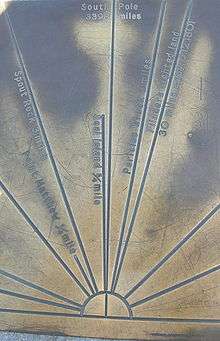St Alouarn Islands

St Alouarn Islands are a group of islands and rocks south-east of Cape Leeuwin in Western Australia, approximately 11 km south of Augusta.
Discovery
In 1772 Louis de St Alouarn in the Le Gros Ventre was in the region as part of the expedition of Kerguelen, and subsequently the islands were named in 1792, after Captain de St Alouarn, by French navigator Antoine d'Entrecasteaux.[1]
Location
The Point Matthew lookout on the road between Augusta and Cape Leeuwin, that has the islands identified in a brass compass plate that also identifies distances.[2]

Wrecks
There are a number of wrecks in the vicinity of Cape Leeuwin.
The best-known wreck near the islands was that of the Aberdeen White Star ship SS Pericles on an uncharted rock on 13 March 1910,[3] within sight of the Cape Leeuwin lighthouse in daylight hours.[4][5][6][7][8]
Whale watching boats leaving from Augusta or Barrack Point (Flinders Bay) tend not to venture into this group of islands and rocks, but travel around Flinders Bay to the east of the islands.
The islands are significant for their bird colonies - with Seal Island and St Alouarn Island being reserves for that purpose.
The named islands, in order of distance from mainland are:
Named islands and rocks
Seal Island
- Seal Island (Augusta, Western Australia) - is a large flat brownish rock, 1.5 km south of Point Matthew.
- possibly named by George Vancouver in 1791, recorded by Archdeacon in 1878 [9]
- Status: Seal Island Nature Reserve - National Parks and Nature Conservation Authority
- Size: approx 4 ha in area - Conservation of Fauna reserve

Saint Alouarn Island
- Saint Alouarn Island 34 24 15 115 11 30
- - 5.5 km south east of Point Matthew
- Saint Alouarn Island Nature Reserve -
- Size: approx 8.5 ha in area - Conservation of Fauna reserve

Flinders Island
- Flinders Islet (also Flinders Island) - 34 21 00 115 20 00
(also identified by some sources as Flinders Island[13]
- Named Island in Admiralty Chart 1037 of 1878
- Vested as 'Flinders Island and various rocks south of Augusta' as 'A' reserve.[14]
- - 7 km south east of Point Matthew

Rocks
Therer are a few named rocks in the group
- Square Rock - 7.5 km south east of Point Matthew
- South-West Breaker - approximately 9 km ssw of Point Matthew is the farthest named rock from the mainland.
Unnamed rocks run parallel to the line of named islands above, between Cape Leeuwin and South-West Breaker, with one exception - Spout Rock, west of Flinders Islet.
Augusta Port
In 2009, the gazettal of the Augusta Port Area [15] delineated the port in reference to the northernmost point (at High water level) on Saint Alouarn Island (with truncated spelling), as well as Seal Island, and Point Matthew.
In 2013 - 2013, the Western Australian government, through the Royalties for Reegions programme, constructed a new harbour outside of the Hardy Inlet area of the Blackwood River mouth.
The port is to the south, and within view of Flinders Bay settlement and boat ramp. It is located adjacent to the road that goes to Cape Leeuwin lighthouse.
Oceangoing vessels had previously anchored in Flinders Bay, or used the Flinders Bay jetty; however, its short-term operation between the 1890s and 1930s subsequently left the bay with no port facility.
See also
Notes
- ↑ Murray, Ian and Hercock, Marion (2008) Where on the Coast is That? Carlisle, Western Australia Hesperian Press ISBN 978-0-85905-452-2
- ↑ First on Admiralty charts in 1878 - probably named after Matthew Flinders - p.234 Murray, Ian and Hercock, Marion (2008) Where on the Coast is That? Carlisle, Western Australia Hesperian Press ISBN 978-0-85905-452-2
- ↑ J.H.W (1911), [Newspaper cuttings on the shipwreck of the Pericles, the Waratah and the Yongala], retrieved 6 April 2012
- ↑ Fyfe, Christopher (1999), Uncharted end : the Pericles disaster, retrieved 6 April 2012
- ↑ Cape Leeuwin and the position of the wreck of the Aberdeen White Star liner Pericles, wrecked 31st March 1910, 1950, retrieved 6 April 2012
- ↑ Pericles - struck submerged rock, total loss, 31 Mar. 1910. Steamer, 10,925 ton. Port of Fremantle quarterly, 1968, Vol.3, no.2, p.14
- ↑ [Pericles - series of articles on her sinking on 31 March 1910 and the salvage of her cargo in the 1950s and 1960s] 1910, 1949, 1957, 1959, 1961-1964, 1968, 1972-1973. http://henrietta.liswa.wa.gov.au/record=b1862037~S2
- ↑ "WESTRALIANA FAUNA FACTS FLORA.". Western Mail (Perth, WA : 1885 - 1954). Perth, WA: National Library of Australia. 1 December 1949. p. 12. Retrieved 6 April 2012.
- ↑ Murray, Ian; Hercock, Marion; Murray, Ian; Hercock, Marion (2008), Where on the coast is that?, Hesperian Press, ISBN 978-0-85905-452-2 page 267
- ↑ 27/05/1960, Government Gazette, p.1435, p.1445
- ↑ 22/12/1972, Government Gazette, p.4770
- ↑ 04/05/1979, Government Gazette, p.1147
- ↑ Murray, Ian; Hercock, Marion; Murray, Ian; Hercock, Marion (2008), Where on the coast is that?, Hesperian Press, ISBN 978-0-85905-452-2 page 106
- ↑ Government Gazette, p.1375, 11/04/1986
- ↑ 26/05/09 Government Gazette, p.1804/1805,
Further reading
- Edward Duyker & Maryse Duyker, ed. & trans) Bruny d’Entrecasteaux: Voyage to Australia and the Pacific 1791—1793, Miegunyah/Melbourne University Press, Melbourne, 2001, ISBN 0-522-84932-6, p. 108.
- Fornasiero, Jean; Monteath, Peter and West-Sooby, John. Encountering Terra Australis: the Australian voyages of Nicholas Baudin and Matthew Flinders, Kent Town, South Australia,Wakefield Press,2004. ISBN 1-86254-625-8
- Godard, P. & Kerros, T. de, Louis de Saint-Aloüarn, Lieutenant des vaisseaux du Roy: Un marin breton à la conquête des Terres Australes, Les Portes du Large, Saint-Jacques-de-la-Lande, 2002.
- CALM/DOLA 1996. Land Management Series Map Sheet 1929-3 Leeuwin Edition 11:50000.
Coordinates: 34°24′S 115°12′E / 34.400°S 115.200°E